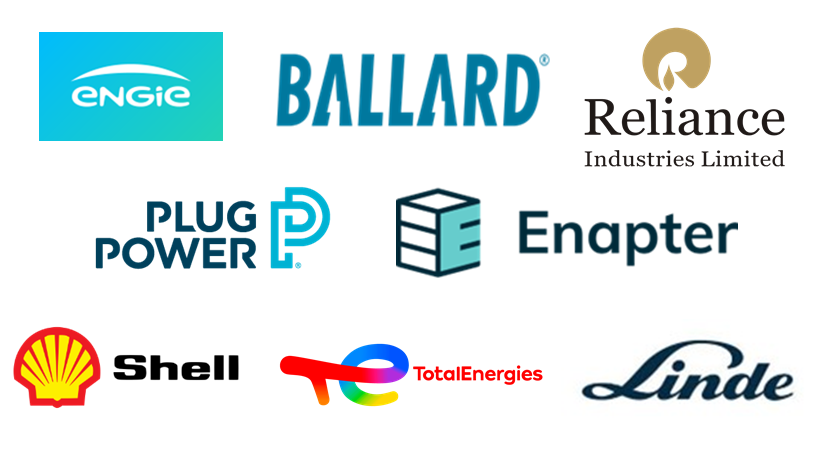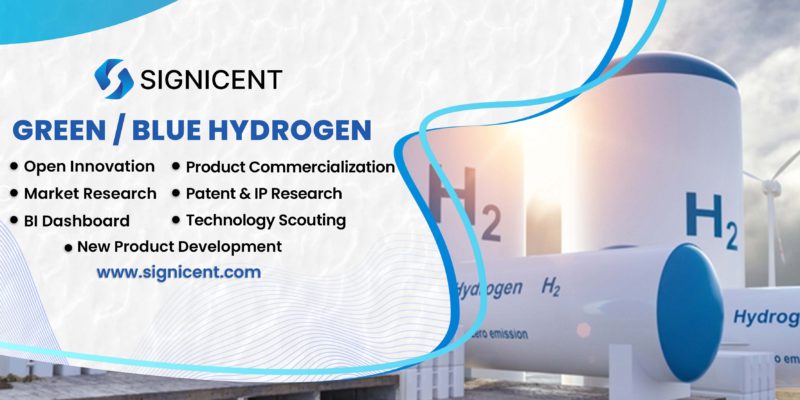The objective of the report is to explore the domain of Green/ Blue Hydrogen. The main focus of the report is to perform a technology intelligence on the Production, Storage & Transportation of green and blue hydrogen. The Green/ Blue Hydrogen report covers the following aspects:
- Scientific literature for process development, scale-up, and optimization of green/ blue hydrogen.
- Focusing on storage and transportation technologies for green/ blue Hydrogen.
Green/ Blue hydrogen is getting prominence as a potential source of clean energy and is frequently referred to as “the fuel of the future”. Green hydrogen is the term used to describe hydrogen gas that has been produced from renewable energy sources, such as solar or wind energy, which does not emit greenhouse gases. The color of hydrogen gas, whether it is green hydrogen, blue hydrogen, grey hydrogen, pink hydrogen, or yellow hydrogen, depends on the energy sources used in its production.
Green hydrogen is a key component of the energy equation and hydrogen is recognized as a primary resource of potential energy. Water electrolysis is used to produce green hydrogen using regenerative energy sources. Hydrogen is a low contamination gas for the atmosphere that can be stored and transformed into heat or energy according to the need. Since hydrogen can be produced using solar energy, it is one of the most prominent circular carbon economy (CCE) strategies.
Blue Hydrogen is likely in high demand as developed nations are investing in an eco-friendly alternative for a cleaner energy source. This is because of the eroding air quality brought on by human activities, including the burning of fossil fuels. This eventually causes a spike in global temperature. Steam Methane Reforming (SMR), Autothermal Reforming, Partial Oxidation, etc. are some of the methods associated with the manufacturing of blue hydrogen.
Challenges Associated
While analyzing the different aspects of green and blue hydrogen, the experts of Signicent found some of the challenges associated with the production, storage, and transportation of green/ blue hydrogen.
- The continuous chemical looping formed by two interlinked fluidized bed reactors has not been widely researched. There have been no trials that show the use of biogas fuel in the CLR process.
- Separate applications of alkaline water electrolysis and proton exchange electrolysis lead to issues like low cell pressure and slow hydrogen production along with high construction, operating, and maintenance costs.
- Hydrogen is typically stored in steel tanks, however, welding creates some weak points that might collapse under stress and crash impact.
- Currently, metallic materials are utilized for hydrogen storage and transportation. However, in a high-pressure hydrogen environment, hydrogen invasion may occur into a metal substance resulting in hydrogen embrittlement.
Emerging Innovations
This section of the report will talk about emerging innovations in hydrogen production, storage, and transportation. The following innovations seem to overcome the challenges discussed above.
Hydrogen Production by CLR process
CLR process is a chemical looping reforming process used to produce green and blue hydrogen. The Institute of Carbochemistry (ICB-CSIC) in Spain has developed a CLR process using reactive and durable Cu-based oxygen carriers. These Cu-based oxygen carriers are a possible substitute for Ni-based materials for the production of hydrogen gas. During the process, the temperature variations affect the hydrogen yield. At an extreme temperature of 900ºC, methane (CH4) conversion reaches 88% while H2 yielded 2.20 mol. With temperature reduction, H2 & CO seem to decrease because of lesser methane conversion. In the CLR process, neither net input of heat is required, nor an excess of heat is recovered.
Production system for mixed electrolysis of water
A green hydrogen production system for hybrid electrolyzed water has been developed by Baowu Clean Energy Co. Ltd., China. This technology improves the utilization rate of the system equipment and maintenance frequency using a real-time cloud server system for hydrogen production. Cloud server is used for remote controlling, enabling the production equipment’s unattended, centralized management, and remote fault diagnosis functions. Maintenance costs can be saved with the reduction in unusual start-stop frequency.
Polyamide Based Hydrogen Storage Tank
DSM (Netherlands) modifies the design of hydrogen tanks. A polymer-based hydrogen fuel storage tank has been created by them using the blow molding technique with a pinch step to make a pinch seamline. With these modifications, the storage tank offers better mechanical and integrity performance during an impact. It has been observed that containers with heat stabilizers embedded in them produced good results and did not break during the test. These modified containers offer various advantages including corrosion resistance, more flexibility in design, reduced noise attenuation, low permeability, etc.
Stainless steel with embrittlement resistance for Hydrogen transportation
Japan’s Tottori Industrial Technology Center has invented stainless steel that is resistant to chemicals and has hydrogen embrittlement property, making it a possible replacement for current metallic materials. The sample in the SSRT test provides values of 0.93 and 0.84, which must be higher than 0.8. As a result, sample with values higher than 0.8 exhibits good resistance to hydrogen brittleness. Even after 528 hours of neutral salt being sprayed on the surface of the embodiment, no rust is produced, proving its remarkable corrosion resistance. At a 400 kPa differential pressure, high temperature (>300 °C) hydrogen is passed which shows the strong barrier properties of material towards pressure and temperature.
Each year Signicent provides consultancy to hundreds of organizations to help transform their innovations to value.
Competitive Intelligence
This section of the Green/ Blue Hydrogen report will cover all the market trends including startups, acquisitions, market size, and key players working significantly on green and blue hydrogen. These insights are very useful in business to build a strategy and strengthen its position in the market.
Startups in Spotlight
Sigma Hydrogen is a Norway-based startup, founded in 2021. Based on innovative digital solutions and with strong, long-lasting partnerships, green hydrogen will assure a sustainable future. Sigma Hydrogen’s technology offers a more profitable production of green hydrogen than the existing methods. It ensures safe, clean, and cost-effective hydrogen production. Sigma Hydrogen is working in collaboration with several partners.

Merger & Acquisition
Fortescue Future Industries (FFI) is an Australia-based company founded in 2020. FFI is fueling the global energy transition by building a strong portfolio of renewable energy and green hydrogen projects. Sparc Technologies Limited is a South Australian company founded in 1999. It focuses on the development of innovative technology solutions.
In February 2022, Fortescue Future Industries acquired stakes in Sparc Hydrogen. Fortescue Future Industries invested $1.8 million to acquire a 20 percent stake in Sparc Hydrogen. Sparc Hydrogen offered FFI the chance to play a substantial role in the global green hydrogen market.
Market Analysis
This section of the Green/ Blue Hydrogen report highlights the insights of market revenue of Green and Blue Hydrogen globally.
The Global Green Hydrogen Market revenue is expected to expand at a CAGR of 55.5% from USD 0.88 Bn in 2021 to reach a value of USD 8.00 Bn by 2026 over the forecast period.
The Global Blue Hydrogen Market revenue is expected to expand at a CAGR of 14.8% from USD 1.05 Bn in 2021 to reach a value of USD 2.09 Bn by 2026 over the forecast period.
Key Players
According to the research and analysis, the leading players working in the production, storage, and transportation of hydrogen gas are listed below:

Recent Report
- Hydrogen Fuel Cells – Harnessing Clean Energy for a Sustainable Future
- Antibacterial & Antiviral Technologies for Personal and Home Care
- Why Waterless Beauty Innovations Are the Next Big Thing in Skincare
- How AI and IoT Improve Inflammable Material Transport Safety
- Vertical Farming Shaping the Future of Agriculture
